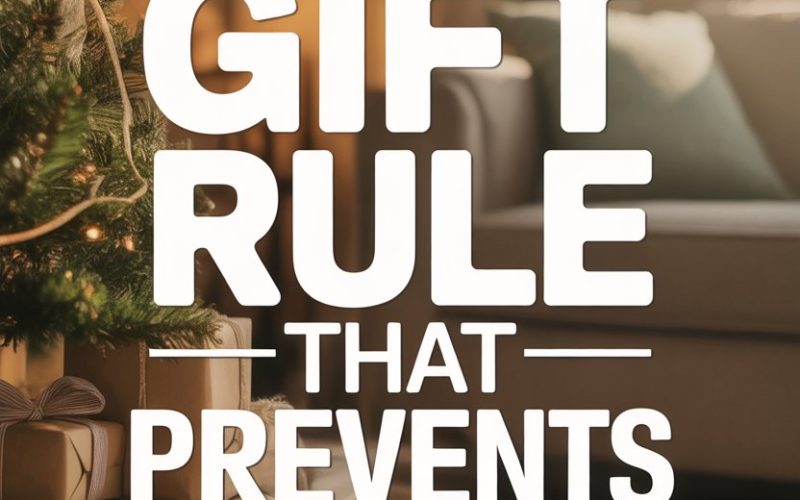If you’ve ever watched your child rip through a pile of birthday presents with all the gratitude of a hungry raccoon at a rubbish bin, you might have wondered: Is there such a thing as too much? (Hint: The answer is yes. It’s written all over your lounge floor.)
There’s a trick many parents are quietly adopting—a gift rule that stops the spoiling before it starts, keeps your budget in check, and turns gift-giving into something meaningful.
What Is the Gift Rule?
Parents are a clever bunch, especially when sleep-deprived.
The gift rule—often called the “Four Gift Rule”—asks you to give your child just four gifts: something they want, something they need, something to wear, and something to read.
It’s simple. It’s flexible. It doesn’t require spreadsheets or a hermit-level commitment to minimalism. And most importantly, it nips that present-induced overwhelm right in the bud.
Why Less Can Be So Much More
Remember that Christmas when you hunted down every item on your child’s wish list, only for the lot to end up under a pile of wrapping paper carnage? You’re not alone.
Researchers from the University of Toledo found that children asked to play in a room with fewer toys played longer and more creatively than those with piles of options. More gifts can actually mean less enjoyment.
The gift rule shifts the focus to quality over quantity. It signals to your child: “We value thoughtful giving, not mountains of stuff.”
How Each Gift Type Supports Your Child
Each of the four presents serves a purpose—not just in filling the toy box, but in shaping how your child perceives giving and receiving.
Something they want
This one’s the wish-list favourite. A toy, a gadget, or that art kit your child has been eyeing for months.
The key here isn’t to go wild, but to choose something your child genuinely desires, showing that you’ve listened to their hopes.
Something they need
Not always glamorous, but this is where you can sneak in those new trainers, a fun lunchbox, or a better water bottle.
If you’ve ever seen the joy on a child’s face when they get their own umbrella, you know “need” can also feel special. Plus, it’s a gentle lesson in gratitude for the everyday.
Something to wear
A new pair of PJs with their favourite characters, a funky hat, or maybe a sparkly pair of wellies. Clothing gifts teach kids to appreciate practical things, while adding a personal twist (unicorn socks, anyone?).
Something to read
Books open the door to whole new worlds, and there’s a special magic in receiving one as a present. Research suggests that reading for pleasure is linked to better academic achievement and emotional well-being.
Selecting a book says, “This made me think of you,” which is a gift in itself.
But What If Grandma Brings Ten Gifts?
Parents everywhere share the same gentle eye-roll when relatives arrive with armfuls of gifts. Family members mean well, but sometimes “spoiling” is their love language.
Have a chat with grandparents, aunts, and uncles ahead of time. Share the gift rule and explain why you’re giving it a go. “We’re trying to make gifts more meaningful this year, and we’d love you to be part of it.”
Better yet, suggest a group gift or invite them to buy the “something to read.”
Will everyone comply? Maybe not. But you’ve set the tone, and that matters.
Practical Ways To Make The Gift Rule Work For Your Family
Every child is different. Every family is different. Luckily, the gift rule isn’t rigid—it’s a framework, not a law.
Some parents tweak it for bigger families: maybe each child gets their “something to wear” from Auntie Sonia, or “something to read” from Nana.
Others add their own spin, such as “something to make” for crafty kids, or “something to experience” like tickets to a show or a zoo trip.
Younger kids might not grasp the categories, but they’ll sense the shift when presents become more personal and less about quantity. Older children can be involved in picking gifts for siblings, or even suggesting their own “wants” and “needs.”
This builds anticipation, and dare I say—appreciation.
The Art of Saying No to Excess
A big reason many parents get tangled in a web of excess is guilt. Maybe you worry your child will feel left out when their mate gets a mountain of presents—especially if social media is full of pastel-filtered photos of toy avalanches.
Remind yourself: Children remember moments, not mountains. A game played together with that new puzzle, or a bedtime story from their new book, will outlast the memory of unwrapping thirty plastic dinosaurs.
It’s not mean. It’s not deprivation. It’s setting your child up for gratitude.
And, as the Harvard Health Blog points out, gratitude is linked to happiness, resilience, and kindness. All things you can’t wrap up with a bow.
Gift Giving Without the Meltdown (Yours or Theirs)
When you give fewer gifts, you can make the moment special. Build a little ceremony into the unwrapping. Take turns opening presents.
Talk about why you chose that book, or how you know those trainers will make school mornings a wee bit easier.
If your child asks why there are fewer gifts this year, keep it simple: “We’re choosing presents that matter. That way, we can enjoy them more.”
Still get pushback? That’s normal.
Kids aren’t immune to the buzz of more, more, more. But given time, most adjust—and may even prefer it. (Just ask the parents who’ve spent a month tripping over unopened presents.)
What About Birthdays?
The gift rule isn’t just for Christmas. Birthdays, graduations, the occasional random Tuesday surprise—it fits any occasion where gift overload is a real threat.
For birthdays, some families use the four-gift rule as their backbone, then add a “memory gift”: a special outing or activity instead of another toy.
Other parents keep it flexible depending on the year, age, or what the child needs most.
The point isn’t to be rigid, but to make giving a little more thoughtful, a little less overwhelming—and a lot less about plastic tat that ends up in landfill.
Saying Yes to Experiences, Not Just Stuff
If you feel the urge to add a fifth category, experiences are a brilliant option. Tickets to a show, a voucher for a day at the swimming pool, or even a “yes day,” where your child gets to pick activities (within reason, of course).
Psychologists have found that experiences bring families closer and create lasting memories, far outlasting the dopamine hit of a new toy.
How to Handle Disappointment
Despite your best efforts, some children (especially those used to a mountain of gifts) may feel disappointed at first. This is normal.
The good news: Disappointment is a skill. Learning to handle “less than expected” builds resilience, emotional intelligence, and, with your support, a new appreciation for what they have.
Use these moments to talk about joy, gratitude, and the meaning behind gifts. Ask your child what their favourite present was and why. Listen.
You might be surprised at the answers—often, it’s the small things that stand out.
Making Traditions That Stick
The beauty of the gift rule is that it grows with your family. As children get older, their idea of a “want” or “need” changes, and so does your approach.
Maybe your teen’s “something to wear” is a beloved hoodie, or “something to read” becomes a magazine subscription. The categories adapt, the intention stays the same.
Traditions matter. They’re the glue that holds family memories together.
And when your children look back, they’ll remember the warmth of those moments, not the size of the pile.
Bringing It All Together
The gift rule isn’t about being strict, stingy, or out of touch. It’s a gentle way to keep generosity meaningful, limit the clutter, and raise children who know how to appreciate what they have.
Will you still step on Lego bricks in the dark? Probably.
But with fewer of them, you’ll at least have a fighting chance to make it to the loo unscathed.
Here’s to gifts that matter, memories that last, and a new kind of family tradition—one with a little less stuff, and a lot more heart.





